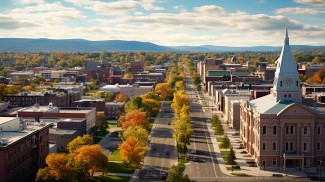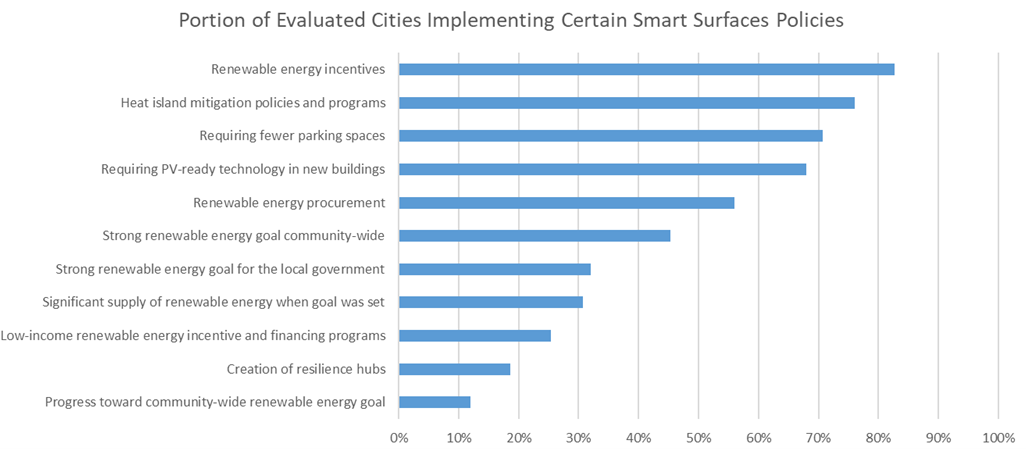Smart surfaces can help communities mitigate extreme heat, reduce greenhouse gas emissions, and improve stormwater management. But data from the 2024 City Clean Energy Scorecard show that cities aren’t adequately providing smart surfaces in low-income and disadvantaged communities.
Smart surfaces—like cool and reflective roofs and pavements, green infrastructure, trees, green roofs, porous and permeable pavement, and solar panels—can mitigate extreme heat and stormwater runoff, resulting in more climate-resilient communities. However, data from ACEEE’s most recent City Clean Energy Scorecard show a range of municipal progress on this front and that most cities need to do more in disadvantaged communities. This is especially important as these communities are more likely to experience disproportionate impacts of climate change.
Smart surfaces can reduce extreme heat, climate pollution, and stormwater runoff
Smart surfaces can be cost-effective investments that deliver a significant impact. They can reduce heat islands. One study found that areas without street trees were five times more likely to experience extreme heat than areas with full tree canopy coverage. An analysis of 93 European cities found that one-third of excess heat deaths in some areas could have been prevented by tree canopy coverage of 30%. Another report found that retro-reflective surfaces on buildings, which reflect sunlight and limit how much heat the urban landscape absorbs, reduced outdoor air temperatures by 2.6 degrees Celsius. Bifacial solar panels with photovoltaic cells on both sides can capture direct sunlight on their front side and reflect sunlight on the back, reducing heat.
Smart surfaces have other benefits, including:
- Improved quality of life. Smart surfaces can improve residents’ quality of life and result in healthier communities. In Texas, researchers found a correlation between neighborhood green space and fewer visits to health-care facilities for mental health purposes, even after adjusting for demographic and socioeconomic factors. These surfaces can also improve air quality.
- Better stormwater management. Rain gardens, bioswales, and other green stormwater infrastructure can help manage stormwater runoff, reducing flooding.
- Reduced greenhouse gas emissions. Smart surfaces can help cities achieve their climate change mitigation goals. Urban parks and solar energy installations can directly reduce greenhouse gas emissions. Cool roofs and shade trees can indirectly reduce emissions by requiring buildings to use less energy for cooling. Heat can also discourage transit ridership, which may push people to rely more on their cars and increase tailpipe emissions. Smart surfaces can mitigate this heat and encourage more transit ridership.
Disadvantaged communities could be better served by smart surfaces
Of the 109 metrics in the 2024 City Clean Energy Scorecard, 11 are related to smart surfaces. These metrics tend to assess the extent to which cities are integrating renewable energy and heat mitigation strategies in their communities. The figure below identifies the share of Scorecard cities that have adopted innovative smart surfaces policies and programs:
As the figure shows, smart surfaces scores ranged from 12% to 83%. Cities most commonly pursue renewable energy incentives and heat island mitigation policies and programs. Almost three-quarters of cities have changed zoning rules to either remove parking minimums or set parking maximums.
On the other hand, cities overall scored poorly on the two metrics that examine the intersection of smart surfaces and equity: low-income renewable energy incentive and financing programs and the creation of resilience hubs. Incentives for low-income residents to access renewable energy exist in only one-quarter of cities. These residents are typically excluded from clean energy technology access due to upfront costs. Similarly, less than 20% of cities scored for creating resilience hubs—which can serve as shelters during extreme weather events—in disadvantaged communities. This metric also assesses whether cities have incorporated clean energy technology, such as solar energy, into resilience hubs.
Adding more smart surfaces in disadvantaged communities is one way cities can help remedy past and present injustices. The study on deaths from heat in European cities found that disadvantaged communities face the brunt of extreme heat due to past and present discrimination. An analysis of American cities found that people of color overwhelmingly live in census tracts with higher heat island intensity than census tracts where non-Hispanic white Americans live and that this is at least in part due to racial segregation. Past segregationist practices such as redlining currently result in redlined neighborhoods experiencing higher temperatures than other neighborhoods within the same city.
All cities have opportunities for progress
Smart surfaces are an effective solution to alleviate climate change impacts. They can provide cities with extreme heat mitigation, improved quality of life, better stormwater management, and greenhouse gas emissions reductions. The 2024 City Clean Energy Scorecard shows that though some cities are performing well in some smart surfaces policy areas, cities overall are not implementing these policies equitably. Policymakers in all cities need to take proactive steps to ensure that the communities most vulnerable to the impacts of climate change are better served by extreme heat mitigation and other benefits provided by smart surfaces.
Technical assistance can help cities advance smart surfaces, so ACEEE partnered with the Smart Surfaces Coalition—a network of more than 40 organizations—to assist 10 cities across the United States in advancing the adoption of smart surfaces at the metropolitan level to enhance environmental sustainability and resilience. ACEEE, along with other partners, provides policy guidance for integrating smart surface measures into city planning and identifies pathways for local governments to secure federal funding.




